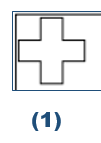
One of the biggest struggles I notice with novice Microsoft Excel users is simply where to “click”. Instructions like, “Double Click the autofill handle” or “Click and drag between the rows,” may not be clear enough. The reason for this is, what the user intends to click on and what they end up clicking on can often be a difference of a fraction of a centimeter. I have seen students who are already uncomfortable with the program get frustrated when they are trying to tell the program to do one thing but they are just slightly off with the mouse. Thankfully Microsoft created a set of dynamic icons, or “looks”, for the cursor that tell the user what will happen before they do it. I always make a point to explain this and I find it eases some of the frustration. The most common issue seems to be selecting the autofill handle. This makes sense because there is a lot going on in the junctions of the cell.
When you try and grab the autofill handle you will get one of the four options above.
 Number (1) is the standard icon you will get as you move around the spread sheet. The thick white cross in this case is suggesting that it’s ready for the user to select a cell, or a range of cells.
Number (1) is the standard icon you will get as you move around the spread sheet. The thick white cross in this case is suggesting that it’s ready for the user to select a cell, or a range of cells.
.png?t=1518603379842)
Number (2) is the cursor icon and is telling the user that they are over the autofill handle. When this thinner black cross is on the screen the user can click and drag, or double click to utilize autofill.
Number (3)means the user has entered edit mode and can change the contents of the cell.
.png?t=1518603379842) Number (4) is the most common “mis-click” when the user is attempting to autofill. This icon is an indication to the user that if they click and drag the cell, they will cut and copy the contents to a new location - a very frustrating experience if that is not what the user wanted. It is an easy mistake to make and it’s not immediately obvious what is wrong. However, if the user knows what the cursor icon is telling them, they can avoid all of that frustration.
Number (4) is the most common “mis-click” when the user is attempting to autofill. This icon is an indication to the user that if they click and drag the cell, they will cut and copy the contents to a new location - a very frustrating experience if that is not what the user wanted. It is an easy mistake to make and it’s not immediately obvious what is wrong. However, if the user knows what the cursor icon is telling them, they can avoid all of that frustration.
Drew Hamilton
Applications instructor
ahamilton@nhlearnninggroup.com
"If all else fails, try Ctrl+Z."

